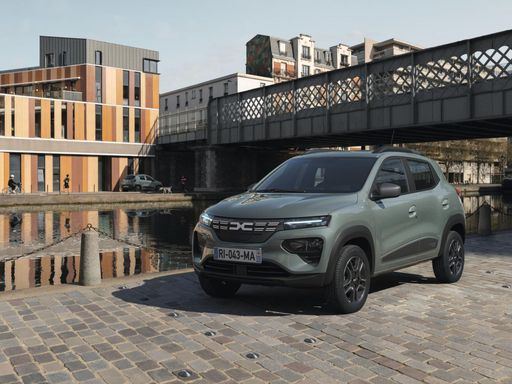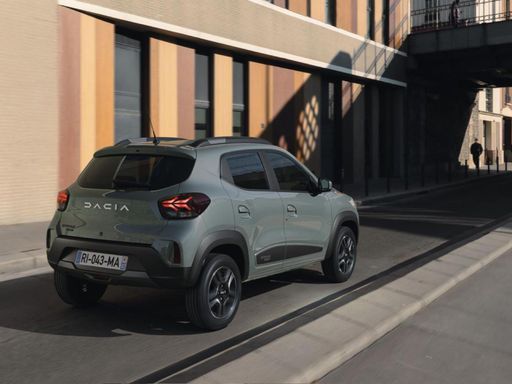Alfa Romeo Junior vs Dacia Spring – Which model is better for everyday use?
Everyday use, family trips or long-distance drives – here’s where the differences show.
Discover whether Alfa Romeo Junior or Dacia Spring fits your lifestyle better.
Costs and Efficiency:
Price and efficiency are key factors when choosing a car – and this is often where the real differences emerge.
Dacia Spring has a convincingly advantage in terms of price – it starts at 14500 £, while the Alfa Romeo Junior costs 25700 £. That’s a price difference of around 11186 £.
In terms of energy consumption, the advantage goes to the Dacia Spring: with 13.20 kWh per 100 km, it’s slightly more efficient than the Alfa Romeo Junior with 15.10 kWh. That’s a difference of about 1.90 kWh.
As for range, the Alfa Romeo Junior performs clearly better – achieving up to 410 km, about 182 km more than the Dacia Spring.
Engine and Performance:
Under the bonnet, it becomes clear which model is tuned for sportiness and which one takes the lead when you hit the accelerator.
When it comes to engine power, the Alfa Romeo Junior has a decisively edge – offering 280 HP compared to 65 HP. That’s roughly 215 HP more horsepower.
In acceleration from 0 to 100 km/h, the Alfa Romeo Junior is decisively quicker – completing the sprint in 5.90 s, while the Dacia Spring takes 13.70 s. That’s about 7.80 s faster.
In terms of top speed, the Alfa Romeo Junior performs distinct better – reaching 206 km/h, while the Dacia Spring tops out at 125 km/h. The difference is around 81 km/h.
There’s also a difference in torque: Alfa Romeo Junior pulls convincingly stronger with 345 Nm compared to 125 Nm. That’s about 220 Nm difference.
Space and Everyday Use:
Whether family car or daily driver – which one offers more room, flexibility and comfort?
Seats: Alfa Romeo Junior offers slightly more seating capacity – 5 vs 4.
In curb weight, Dacia Spring is noticeable lighter – 1013 kg compared to 1380 kg. The difference is around 367 kg.
In terms of boot space, the Alfa Romeo Junior offers distinct more room – 415 L compared to 308 L. That’s a difference of about 107 L.
In maximum load capacity, the Alfa Romeo Junior performs distinct better – up to 1280 L, which is about 276 L more than the Dacia Spring.
When it comes to payload, Alfa Romeo Junior clearly perceptible takes the win – 420 kg compared to 302 kg. That’s a difference of about 118 kg.
Who comes out on top?
Overall, the Alfa Romeo Junior shows itself to be wins the duel decisively and secures the title of DriveDuel Champion.
It convinces with the more balanced overall package and proves to be the more versatile choice for everyday use.
 @ Alfa Romeo / Stellantis Media
@ Alfa Romeo / Stellantis Media
Alfa Romeo Junior
Alfa Romeo Junior
The Alfa Romeo Junior captures the essence of Italian design with its sleek lines and compact dimensions, making it an icon of elegance and performance. With a spirited driving experience and a charming retro aesthetic, it appeals to enthusiasts and casual drivers alike. This delightful car embodies the brand's rich heritage while remaining a fun and engaging option for those seeking a unique automotive experience.
details @ Alfa Romeo / Stellantis Media
@ Alfa Romeo / Stellantis Media
 @ Alfa Romeo / Stellantis Media
@ Alfa Romeo / Stellantis Media
 @ Alfa Romeo / Stellantis Media
@ Alfa Romeo / Stellantis Media
Dacia Spring
The Dacia Spring stands out as an affordable and environmentally friendly option in the electric vehicle market, combining practicality with a compact design ideal for urban settings. Its minimalist interior, while basic, provides all the essential features needed for a comfortable drive, reflecting its cost-effective approach. The vehicle's performance suits city driving, making it an appealing choice for those seeking an entry-level electric car.
details @ Dacia / Renault Group Media
@ Dacia / Renault Group Media
 @ Dacia / Renault Group Media
@ Dacia / Renault Group Media
 @ Dacia / Renault Group Media
@ Dacia / Renault Group Media
 @ Alfa Romeo / Stellantis Media
@ Alfa Romeo / Stellantis Media
|
 @ Dacia / Renault Group Media
@ Dacia / Renault Group Media
|
|
|
|
Costs and Consumption |
|
|---|---|
|
Price
25700 - 41600 £
|
Price
14500 - 17100 £
|
|
Consumption L/100km
4.8 - 5.4 L
|
Consumption L/100km
-
|
|
Consumption kWh/100km
15.1 - 17.5 kWh
|
Consumption kWh/100km
13.2 - 14.1 kWh
|
|
Electric Range
344 - 410 km
|
Electric Range
225 - 228 km
|
|
Battery Capacity
0.4 - 51 kWh
|
Battery Capacity
26.80 kWh
|
|
co2
0 - 119 g/km
|
co2
0 g/km
|
|
Fuel tank capacity
44 - 45 L
|
Fuel tank capacity
-
|
Dimensions and Body |
|
|---|---|
|
Body Type
SUV
|
Body Type
SUV
|
|
Seats
5
|
Seats
4
|
|
Doors
5
|
Doors
5
|
|
Curb weight
1380 - 1689 kg
|
Curb weight
1013 - 1050 kg
|
|
Trunk capacity
340 - 415 L
|
Trunk capacity
308 L
|
|
Length
4173 mm
|
Length
3701 mm
|
|
Width
1781 mm
|
Width
1583 mm
|
|
Height
1505 - 1538 mm
|
Height
1519 mm
|
|
Max trunk capacity
1205 - 1280 L
|
Max trunk capacity
1004 L
|
|
Payload
390 - 420 kg
|
Payload
265 - 302 kg
|
Engine and Performance |
|
|---|---|
|
Engine Type
Electric, Petrol MHEV
|
Engine Type
Electric
|
|
Transmission
Automatic
|
Transmission
Automatic
|
|
Transmission Detail
Dual-Clutch Automatic, Reduction Gearbox
|
Transmission Detail
Reduction Gearbox
|
|
Drive Type
Front-Wheel Drive, All-Wheel Drive
|
Drive Type
Front-Wheel Drive
|
|
Power HP
136 - 280 HP
|
Power HP
44 - 65 HP
|
|
Acceleration 0-100km/h
5.9 - 9.1 s
|
Acceleration 0-100km/h
13.7 - 19.1 s
|
|
Max Speed
150 - 206 km/h
|
Max Speed
125 km/h
|
|
Torque
230 - 345 Nm
|
Torque
113 - 125 Nm
|
|
Number of Cylinders
3
|
Number of Cylinders
-
|
|
Power kW
100 - 207 kW
|
Power kW
33 - 48 kW
|
|
Engine capacity
1199 cm3
|
Engine capacity
-
|
General |
|
|---|---|
|
Model Year
2024 - 2025
|
Model Year
2024
|
|
CO2 Efficiency Class
A, C, D
|
CO2 Efficiency Class
A
|
|
Brand
Alfa Romeo
|
Brand
Dacia
|
What drive types are available for the Alfa Romeo Junior?
Available configurations include Front-Wheel Drive or All-Wheel Drive.
The prices and data displayed are estimates based on German list prices and may vary by country. This information is not legally binding.
